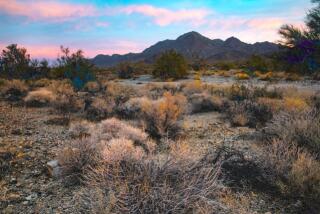Science / Medicine : Exhibit Examines Joshua Tree Deserts
- Share via
Many types of deserts can be found in California, and two of them come together in Joshua Tree National Monument, about 50 miles from Palm Springs.
Below 3,000 feet, the Colorado Desert predominates in the eastern half of the park and includes such low-desert plants as the Jumping Cholla and the Ocotillo. Extensive Joshua Tree forests are in the higher, slightly cooler and wetter Mojave Desert in the western part of the monument.
The flora, fauna and unusual geology of this area are the subjects of the natural science exhibit at the Palm Springs Desert Museum in Palm Springs. After seeing the exhibit, visitors can take the short drive to the monument to experience this fascinating area. Call (619) 325-7186.
SCIENCE FOR KIDS
The Los Angeles Children’s Museum in downtown Los Angeles will expand its Disabilities/Meeting Challenges workshops to an entire weekend this month. Activities will include demonstrations by wheelchair-bound people, role-playing for children and an exhibit where kids can learn how a wheelchair works. Jan. 28 and 29. Call (213) 687-8800.
Children can make their own weather gauges and learn about different weather phenomena in a meteorological workshop at the Natural History Museum of Los Angeles County on Jan. 28 at 1 p.m. Reservations are required. On Jan. 29, at 3:15 p.m. Tigers, one of the most endangered animals on Earth, will be the subject of the family program at the museum. Call (213) 744-3335.
MARINE SCIENCE
Sea anemones and sea urchins are among the animals visitors may see on a series of naturalist-led weekend tide pool explorations during low tide, now through March 19 at the Cabrillo Marine Museum in San Pedro. Call (213) 548-7563.
John Olguin, founder of the Cabrillo Marine Museum, will be the closing speaker in the NOAA lecture series “Our Oceans: Past, Present and Future” at the Santa Barbara Museum of Natural History. Jan. 26 at 7:30 p.m. Call (805) 966-7107.
GEOLOGY
As part of Orange County’s centennial celebration, the Fullerton Museum Center is featuring an exhibit examining the physical forces, such as earthquakes, that have shaped the county. Part one of this three-part exhibit runs through Feb. 26. Call (714) 738-6545.
The Discovery Hall of the San Bernardino County Museum reopens this month with a new exhibit on volcanoes, earthquakes and other geologic phenomena. Children can crawl through a simulated volcano or walk along a floor that imitates the movements of an earthquake in this updated exhibit. Call (714) 792-1334.
PALEONTOLOGY
The evolution of the horse from the dog-sized Hyracotherium to its present form will be the focus of a seminar offered by the Natural History Museum of Los Angeles County. A tour of the museum’s Vertebrate Paleontology Lab and an examination of current research on horse fossils in the Anza-Borrego Desert are included in the course, which begins Feb. 1. Call (213) 744-3342.
More to Read
Sign up for The Wild
We’ll help you find the best places to hike, bike and run, as well as the perfect silent spots for meditation and yoga.
You may occasionally receive promotional content from the Los Angeles Times.






